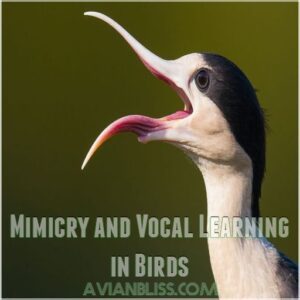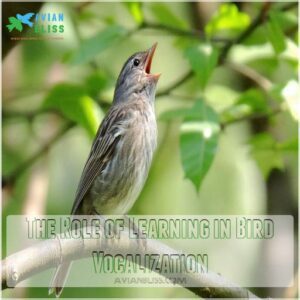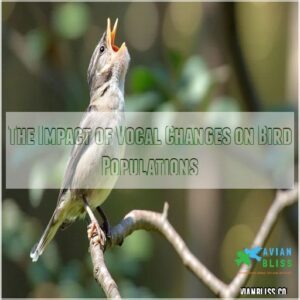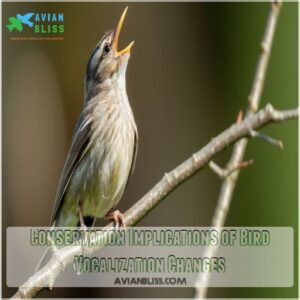This site is supported by our readers. We may earn a commission, at no cost to you, if you purchase through links.
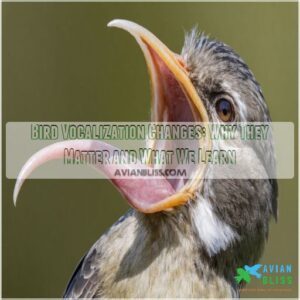
These changes occur due to environmental factors, social interactions, and developmental stages.
For instance, birds can shift their songs in response to urban noise, much like how you might raise your voice in a bustling café.
Their ability to control pitch and volume by adjusting trachea tension lets them convey complex messages, often dazzling us with melodies akin to nature’s own symphony.
Understanding these vocal changes helps us decode how birds navigate their world, hinting at deeper insights into their survival and evolution.
Curious yet?
Table Of Contents
- Key Takeaways
- Why Do Birds Change Vocalizations
- Mechanisms of Bird Vocalization Changes
- Types of Bird Vocalization Changes
- The Role of Learning in Bird Vocalization
- The Impact of Vocal Changes on Bird Populations
- Decoding Bird Vocalizations
- Conservation Implications of Bird Vocalization Changes
- Frequently Asked Questions (FAQs)
- What is bird vocalization?
- Can bird vocalizations be decoded?
- Why do birds vocalize?
- Do bird vocalizations develop innately?
- Does vocal adjustment affect bird populations?
- What sounds do birds make?
- Why has my birds voice changed?
- Why is my bird making different noises?
- Do bird calls change over time?
- Why do birds change their songs?
- How do birds learn dialects?
- What triggers vocalization changes?
- Do all bird species change their calls?
- How fast do changes occur?
- How are songs passed to offspring?
- Conclusion
Key Takeaways
- You’ll notice birds adapt their vocalizations to environmental changes, like urban noise, to maintain effective communication.
- Birds modify their songs through social interactions and developmental stages, highlighting their adaptability and complex communication skills.
- Changes in vocalizations can influence mate attraction, social status, and territorial defense, impacting bird populations.
- Understanding bird vocalization shifts offers insights into their ecological responses and showcases their resilience and adaptability.
Why Do Birds Change Vocalizations
You might think birds sing the same old tunes day after day, but environmental changes, growing up, and even chatty neighbors can cause them to adjust their vocalizations.
Just like a teenager trying out new slang, birds modify their songs and calls in response to these influences, showcasing their adaptability and communication skills.
Environmental Factors Influence Vocal Changes
Ever wondered why a bird’s song sounds different depending on where it lives? Several environmental factors influence these changes. Think of it like this: birds are adjusting their "vocabulary" to their surroundings.
Here are four key factors:
- Noise pollution: City birds sing louder to be heard over traffic.
- Habitat loss: Shrinking habitats force birds to adjust calls to find mates.
- Climate change: Shifting weather patterns may alter bird songs.
- Food availability: A bird’s song can even reflect how much food is around.
Developmental Stages Affect Vocalizations
As birds grow, their vocalizations evolve, much like how kids’ first babbles turn into full sentences.
Early-life learning shapes avian vocalization, paving the way for complex song patterns.
In the nest, chicks start with simple calls, honing their skills as they mature.
Imagine nestling calls as practice runs in bird song learning, essential during developmental stages.
Social Interactions Drive Vocal Adjustments
In the bird world, social interactions spark vocal adjustments, akin to swapping anecdotes at a lively family gathering.
Consider these factors:
- Bird dialects form, like local accents.
- Mating calls evolve to attract partners.
- Group cohesion is maintained through song.
- Territorial defense signals boundary warnings.
- Just as social status songs products Songs for Social Status reflect human social hierarchy,
- Social status impacts vocal shifts, revealing hierarchy.
Each tweak adds depth to avian communication.
Mechanisms of Bird Vocalization Changes
As you explore the mechanisms behind bird vocalization changes, you’ll find that the magic happens in their brains, where regions involved in vocal learning show surprising similarities to humans.
These neurological adaptations help birds sing complex melodies.
They might also explain why your parrot occasionally sounds like your phone ringing.
Brain Regions Involved in Vocal Learning
Imagine birds adjusting their tunes like rock stars fine-tuning a guitar before a gig.
Birds achieve this vocal agility thanks to their unique vocal anatomy, like the syrinx voice box, that enables them to produce a wide range of pitches and sounds.
Inside the avian brain, regions such as the robust nucleus and the HVC drive vocal learning.
These parts are like musical directors, ensuring each note of bird song hits just right, reflecting nature’s own jam session.
It’s a fascinating glance into bird communication.
Genetic Similarities With Humans
You’re not alone if you’ve ever wondered about human-bird communication similarities.
It’s fascinating that shared brain regions reveal how both species evolve vocal learning.
Consider these intriguing points:
- Gene regulation during vocalization
- Genome sequencing highlights convergent evolution
- Unexpected parallels with human speech disorders
- Insights into gene expression
Birds, much like us, have a knack for chatter!
Neurological Adaptations for Vocalization
Imagine the bird brain evolution as a symphony of neural adaptations.
Vocal motor control and the syrinx development let birds master vocal learning.
This neurobiology marvel involves brain regions with neural plasticity, tweaking connections for perfect song delivery.
Vocal learning genes dance through gene expression changes, shaping how birds adapt their vocalizations amid environmental chatter, a true example of nature’s creativity.
Types of Bird Vocalization Changes
You’ll find that bird vocalizations aren’t static; they change over time, showing variations in song patterns, call types, and frequencies.
Think of it like bird dialects – some birds even mimic others, showcasing amazing vocal learning abilities, sometimes to hilarious effect!
Changes in Song Patterns Over Time
Why do bird songs shift over time? Bird song evolution reflects environmental influences like climate change and urbanization.
This adaptive process includes:
- Dialect formation: Birds in different regions develop distinct "accents."
- Vocalization change detection: Helps track ecological changes.
- Vocalization change in response to stress: Adjustments improve survival.
- Bird song plasticity: Flexibility to alter tunes aids communication in dynamic habitats.
Variations in Call Types and Frequencies
As you learn about bird vocalization changes over time, you’ll find variations in call types and frequencies fascinating.
Environmental influences, social contexts, and developmental changes all play a part.
Birds adapt their songs based on geography and species-specific calls.
This dynamic interaction highlights the complexity of avian communication, showing how vocalization changes respond to stress and influence social roles.
| Factor | Example | Influence |
|---|---|---|
| Environmental | Urban vs. rural noises | Adaptation |
| Social Context | Mating season calls | Engagement |
| Developmental Changes | Young chicks learning | Growth |
Mimicry and Vocal Learning in Birds
Ever wonder how birds became master imitators? Mimicry and vocal learning in birds, like songbirds and drongos, are fascinating aspects of avian evolution and communication. Here’s what makes it tick:
- Mimicry lets birds copy predator calls to trick rivals.
- Vocal learning refines their song dialects.
- Evolution shapes vocal changes for adaptation.
The Role of Learning in Bird Vocalization
When you think about how birds learn to sing, it’s like a feathery karaoke session where young songbirds mimic their elders and tweak their tunes based on what they hear around them.
Just like people mastering the art of conversation, these avian vocalists practice tirelessly, even eavesdropping on their feathered friends to perfect their melodies.
Songbirds Learn From Elders and Environment
Have you ever wondered how songbirds pick up their tunes? It’s not just by chance. They learn from both elders and their surroundings, shaping their melodies across different vocal learning stages. This cultural transmission leads to distinct songbird dialects and fascinating avian evolution.
| Learning Aspect | Description | Example |
|---|---|---|
| Elders’ Influence | Mimicking experienced birds | Chickadee parent songs |
| Environmental Impact | Adaptation to local sounds | City vs. rural songs |
| Dialects Formation | Unique regional changes | Regional sparrow songs |
Vocal Practice and Perfection in Birds
Songbirds perfect their tunes like rock stars honing riffs.
They practice tirelessly, tweaking notes, refining melodies, and using feedback to improve.
This vocal development goes through stages:
- Imitation: Copying elders’ songs.
- Practice: Repetition boosts skill.
- Feedback: Self-assessment and adjustment.
- Performance: Achieving song perfection.
These steps showcase complex avian cognition and song learning abilities.
Eavesdropping as a Learning Mechanism
Many birds are skilled eavesdroppers.
They learn by listening to others, picking up songs and calls.
Think of it as their version of a language class!
This social learning shapes their vocalizations, influencing their bird song evolution and even how they learn dialects.
By paying attention to sound details like pitch, rhythm, and repetition in bird songs and calls guide, researchers can better understand this process.
A chickadee’s calls, for instance, might change based on what it hears.
Vocal mimicry is another aspect of this process, contributing to bird vocalization changes and making avian vocalization analysis fascinating.
The Impact of Vocal Changes on Bird Populations
When birds adjust their vocalizations, it’s not just an avian remix but a key factor that affects their ability to attract mates, assert social status, and defend territories.
You might think of it like a bird having to master a new pop song to stay relevant in the ever-changing avian social scene.
Vocal Adjustments Affect Mate Attraction
You might find it surprising how much vocal changes influence birds’ love lives. A bird’s song isn’t just noise; it’s a bachelor’s pitch in the avian dating scene. From intricate melodies to catchy calls, these acoustic signals are:
- Evidence of health and energy
- Indicators of environmental adaptability
- Tools for attracting females, such as through specific bird mating calls
- Tools for attracting females
- Ways to deter rival suitors
- Clues for avoiding inbreeding
Changes in Vocalizations Influence Social Status
Bird vocalizations aren’t just for attracting mates; they also influence social hierarchies.
If you’ve ever heard a bird "bragging" with its calls, you’re witnessing how vocal skills can boost status and dominance.
Birds use loud cries to express fear, joy, stress, and excitement, such as expressing loneliness, which can affect their social standing.
| Aspect | Dominance | Hierarchy | Competition |
|---|---|---|---|
| Vocal Learning | Sharpens skills | Reinforces rank | Spurs rivalry |
| Social Behavior | Signals power | Establishes order | Fosters contest |
Birds engage in song duels, akin to playful taunts.
Vocalizations Affect Territorial Defense
Among birds, sound is your sword and shield for territorial defense. Effective vocalizations can ward off rivals and attract mates. Remember:
- Bird song helps define territory size.
- Call frequency warns predators away.
- Vocal competition maintains dominance.
- Vocal learning adapts to evolving threats.
- Species-specific communication strengthens group cohesion.
With these strategies, your territory stays secure.
Decoding Bird Vocalizations
When you’re trying to understand bird vocalizations, context is everything since a single chirp might mean "danger" or "I’m just chilling."
With technology at your fingertips, you can analyze call types and frequencies to decipher these feathered mysteries, turning every tweet into a tale.
The Importance of Context in Decoding
The subtle shifts in bird vocalizations can be like trying to understand a friend suddenly speaking pirate – context is everything.
In nature, knowing when a bird’s call signals a predator or simple social chatter can mean life or lunch.
With the use of a Bird call decoder tool, enthusiasts can better grasp these subtleties and uncover the secrets of avian communication.
| Call Type | Context | Meaning |
|---|---|---|
| Warning Call | Predator nearby | Prepare to flee |
| Mating Call | Breeding season | Potential partner attraction |
| Alarming Call | Unknown danger | Seek cover or hide |
Understanding these nuances helps demystify the avian world.
Recognizing Different Call Types and Frequencies
Their varied calls and songs are a bird’s voice, revealing much about their world.
Listen closely; a high-pitched chirp might signal alarm, while a low rumble could indicate contentment.
Different bird species have unique vocal signatures – think of it as their own Bird dialects.
Call frequency varies widely, impacting sound analysis and species identification.
Understanding these nuances is essential for comprehending bird vocalization; even slight vocalization changes matter.
Using Technology to Analyze Bird Vocalizations
Spotting different call types is just the start; now tech takes the lead.
Think acoustics on steroids.
Imagine AI-powered identification tools that make analyzing bird songs as easy as humming a tune.
With machine learning and acoustic monitoring, bioacoustics researchers map soundscapes, revealing vocalization secrets.
It’s like listening to nature’s true podcast, no subscription required.
Conservation Implications of Bird Vocalization Changes
When you listen to birds, you’re not just enjoying nature’s playlist—you’re also getting valuable insights into conservation needs.
Bird vocalization changes might seem like nature’s in-flight entertainment, but they can reveal the impact of habitat loss and help guide us in preserving these important natural symphonies.
Monitoring Changes in Bird Vocalizations
Did you ever wonder about tuning into birds’ secret conversations?
Monitoring changes in bird vocalizations is like eavesdropping on nature’s party line.
Here’s how you can start:
- Acoustic monitoring for real-time insights.
- Bioacoustics tools to decode their calls.
- Soundscape analysis tracks vocal dialects.
- Species identification helps gauge urbanization impacts.
Birds never talk behind your back!
Assessing The Impact of Habitat Loss on Vocalizations
You might picture birds serenading through dense forests, but habitat loss alters their vocal symphony.
As trees fall, birds adapt—or fail—to changing environments, affecting acoustic diversity.
This isn’t just about losing a tune; it throws off social signals, breeding cues, and predator warnings.
Soundscape degradation from urban sprawl and noise impedes bird communication, demanding urgent attention.
Using Bird Vocalizations as a Conservation Tool
Imagine bird songs as nature’s acoustic barometer.
Soundscape mapping captures vocal diversity, revealing shifts due to acoustic pollution and habitat change.
Monitoring bird vocalizations with acoustic indices is like having a wildlife detective on call, highlighting bird population declines.
This method aids habitat restoration by pinpointing areas in need.
It’s a powerful, melodic tool for conservation efforts.
Frequently Asked Questions (FAQs)
What is bird vocalization?
Bird vocalization refers to the sounds birds make for communication, like songs and calls.
These sounds are complex and serve purposes such as attracting mates, signaling danger, or marking territory.
Bird vocalization showcases birds’ intricate social interactions.
Can bird vocalizations be decoded?
Think cracking a bird’s code is impossible? It’s not.
Birds’ calls and songs are complex but researchers use context, frequency, and syntax to understand them.
Just like your favorite tunes, their vocalizations hold surprising depth and meaning.
Why do birds vocalize?
Birds vocalize to communicate with each other for various reasons like attracting mates, defending territories, or warning about predators.
Their songs and calls form a complex language that conveys emotions, intentions, and essential survival information.
Do bird vocalizations develop innately?
Birdsong doesn’t just pop out fully formed—it’s a mix of innate instincts and learned skills.
Mimicry and practice polish those musical chops.
Imagine a young sparrow hearing its first tune; genetics lay the foundation, but practice and mimicry polish those musical chops.
Does vocal adjustment affect bird populations?
Vocal adjustment in birds can influence population dynamics by affecting mating success, territory establishment, and survival.
Birds adapt their calls to environmental changes, which can impact communication efficiency and ultimately alter their reproductive success and community structure.
What sounds do birds make?
Bird calls can sound like a wildly eclectic symphony!
From melodic songs to raucous squawks, birds create sounds for mating, warning, or claiming territory.
Their intricate calls resemble a shared language, filled with intention and communication.
Why has my birds voice changed?
Your feathered friend’s voice shift? Age, illness, or even a new environment could be the culprit. It’s best to consult an avian vet to pinpoint the cause.
Why is my bird making different noises?
Did you know bird calls can shift with mood or environmental changes?
Maybe your feathered friend is stressed or learning new sounds, like picking a favorite pop song.
Make sure it’s not illness, and offer varied stimuli.
Do bird calls change over time?
Yes, over time, bird calls can change due to factors like habitat variation and social interactions.
For instance, songbirds might adapt their tunes as their environment shifts or to better communicate with other birds.
Why do birds change their songs?
Birds change their songs due to environmental variations, social interactions, and adaptation pressures.
It’s like a birdie remix to keep up with new neighbors or threats, ensuring their tunes stay fresh and effective for communication.
How do birds learn dialects?
You learn bird dialects like picking up local slang—through exposure and social learning.
Birds mimic sounds from flock members, leading to unique regional variations.
It’s like avian cultural exchange, fostering bonds and community identity.
What triggers vocalization changes?
Vocalization changes in birds are often triggered by environmental factors, social interactions, and learning opportunities.
Shifts in habitat, interaction with different groups, and changes in population dynamics can encourage variations in their vocal patterns and dialects.
Do all bird species change their calls?
Around 50% of bird species modify their calls in response to environmental changes or social interactions.
While not all birds adapt their vocalizations, many display impressive flexibility, kind of like adapting your playlist to your current mood.
How fast do changes occur?
Bird vocalizations change at varying speeds. Some shifts are gradual, spanning generations, while others, like those triggered by environmental changes, happen much faster. It’s a complex, fascinating process.
How are songs passed to offspring?
Imagine parents singing lullabies and kids mimicking them.
In birds, it’s similar; they learn songs from adult tutors, usually their parents.
This learning involves listening closely, practicing, and perfecting over time, just like humans learning speech.
Conclusion
Picture a mockingbird amid city noise, adapting its song to stand out.
These bird vocalization changes reveal a world where birds adjust, learn, and evolve.
Understanding these shifts helps you appreciate how birds thrive despite challenges, whether it’s attracting a mate or defending territory.
By examining their melodies, we gain insights into both their social dynamics and ecological responses.
Stay curious—these feathered singers have much to teach us about resilience and adaptability.







